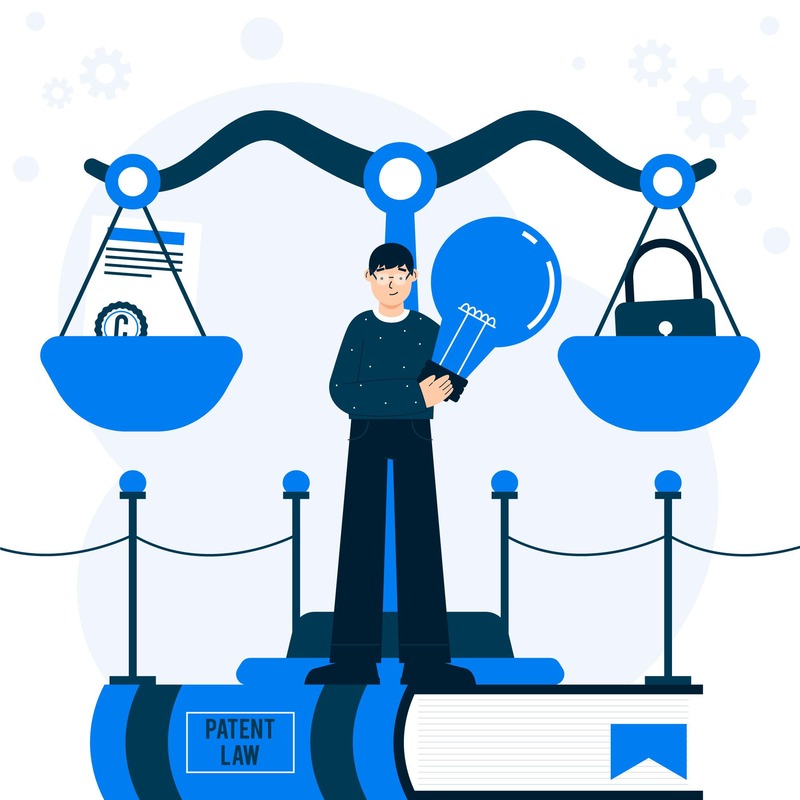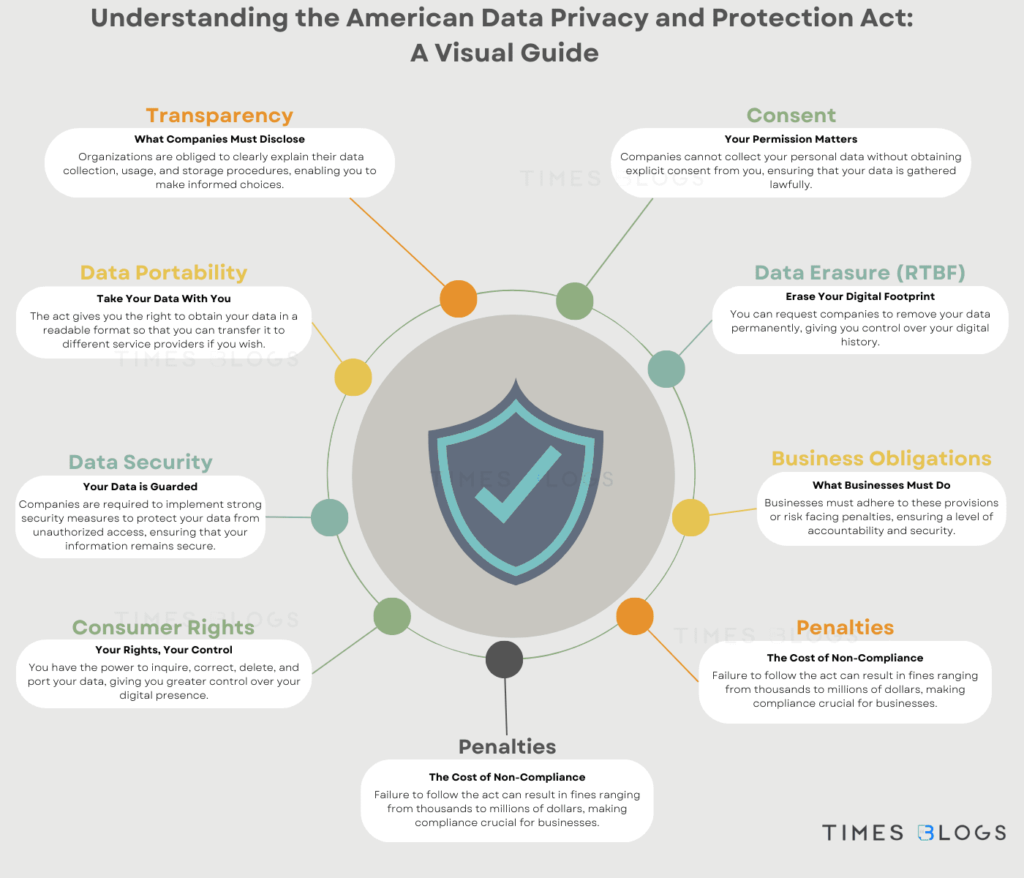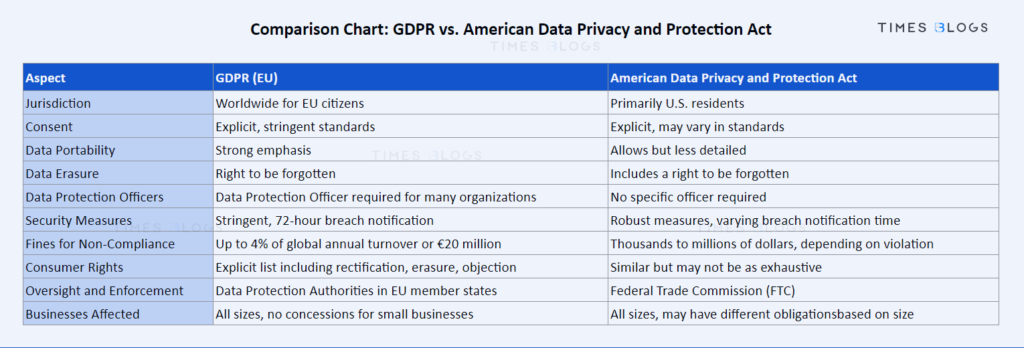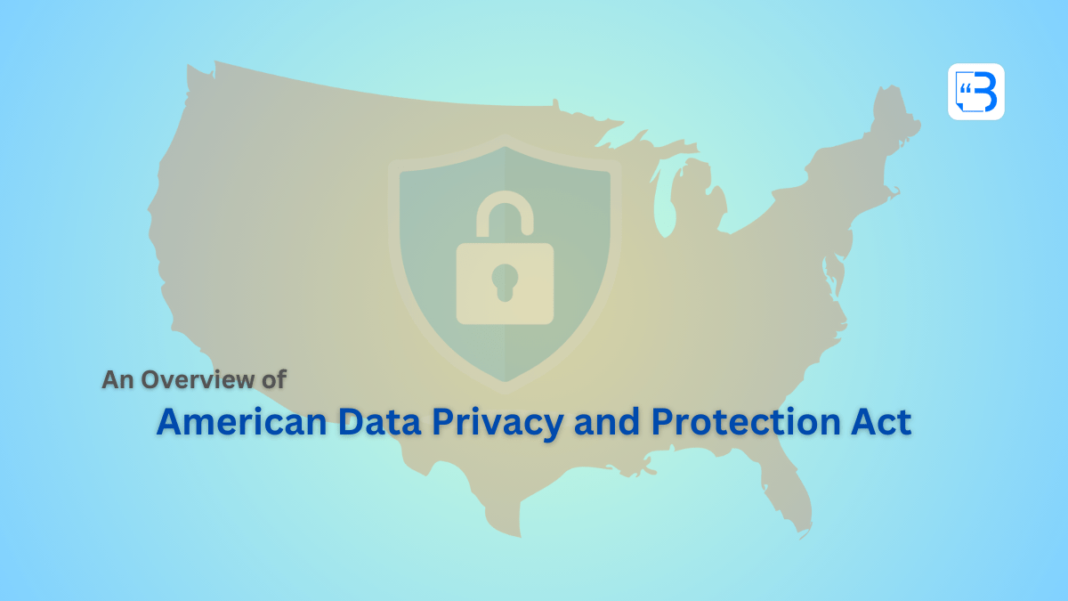In today’s digital age, data is as valuable as gold, driving both individual decisions and corporate strategies. However, this treasure trove is not just any asset; it is intrinsically personal, encompassing details ranging from your name to your Social Security number. The stakes for protecting such information are incredibly high, giving rise to the need for robust data governance measures.
Enter the American Data Privacy and Protection Act, a seminal piece of U.S. legislation designed to safeguard this invaluable resource. The act serves as a comprehensive framework for how data should be collected, stored, and used, setting stringent guidelines that organizations must follow.
This guide aims to delve deep into this crucial legislation, providing an overview of its historical context, its implications for businesses, and its empowering effects on you as a consumer. Armed with this knowledge, you can better navigate the increasingly complex landscape of data privacy and protection.
Table of Contents
Introduction to the American Data Privacy and Protection Act: Elevating Individual Control Over Personal Data
In our digitized society, personal data has emerged as a form of currency—valuable not only to individuals but also to companies and governments. The risk associated with the collection and use of this data is ever-increasing. From identity theft to unauthorized data sharing, the problems are complex and varied. Cue the American Data Privacy and Protection Act—a landmark piece of legislation designed to address these challenges head-on.
What is the American Data Privacy and Protection Act?
At its core, the American Data Privacy and Protection Act is a comprehensive law enacted to standardize and elevate data protection measures across the United States. It aims to govern the way organizations—both public and private—collect, use, and store personal data. The act recognizes the significance of individual privacy and seeks to give people greater control over their own information.
Who Does It Affect?
The reach of the act is extensive and covers all organizations that collect data from U.S. residents, regardless of where the organization is based. This means that even companies outside of the U.S. must comply if they hold or process data belonging to American residents. Moreover, it affects individuals too, granting them new rights concerning their personal data.
Key Objectives of the Legislation
- Enhance Transparency: The act calls for complete transparency in how companies collect, store, and use data. This aims to build trust between consumers and organizations.
- Establish Consumer Control: One of the key elements of the act is to give control back to the people. Individuals should be able to access, correct, or delete their data whenever they wish.
- Uniformity Across States: Before this act, data protection laws were fragmented and specific to each state. This legislation aims to unify those laws into a single, national standard.
- Strengthen Data Security: Companies are required to implement robust security measures to protect consumer data from unauthorized access, leaks, and breaches.
- Accountability and Compliance: Organizations are accountable for protecting consumer data. They must perform regular audits and assessments to ensure they’re in compliance with the law.
Consequences of Non-Compliance
The act is not merely symbolic; it has teeth. Organizations found in violation could face substantial fines, legal actions, and reputational damage. Depending on the severity of the violation, companies could even be forced to cease operations.
The American Data Privacy and Protection Act serves as a pivotal step toward the responsible use of personal data. It takes a 360-degree approach, balancing the needs of businesses to collect and use data for legitimate purposes with the rights of individuals to have greater control over their personal information.
By setting stringent guidelines and penalties, the act is poised to usher in a new era of data protection in the United States. It is not just a regulation but a cultural shift, championing the importance of data privacy in the modern world.
The gravity of this legislation demands attention. Whether you’re a business leader figuring out how to comply or a consumer curious about your new rights, understanding the American Data Privacy and Protection Act is imperative in today’s data-centric landscape.

Historical Background: The Need for Data Protection in a Digital Age
As we dive deeper into the subject, it’s crucial to understand the historical context that laid the groundwork for the American Data Privacy and Protection Act. This will help us appreciate why the act was not just necessary but downright imperative for safeguarding personal data in today’s highly interconnected world.
The Pre-Digital Era and Fragmented Legislation
Long before the internet became an integral part of our lives, data privacy was a relatively straightforward matter. Personal data was mostly stored in physical files, and unauthorized access typically involved tangible acts like stealing or unauthorized copying. As we moved into the digital age, however, the scenario changed dramatically.
Surge of the Digital Era
With the advent of the internet and rapid technological advancements, data started moving from file cabinets to cloud storage. Online transactions, social media platforms, and digital health records have turned personal data into a constantly traded commodity. While these advances offer unprecedented convenience and connection, they also pose new risks like hacking, unauthorized data sharing, and identity theft.
Existing Laws: A Patchwork of Measures
Before the American Data Privacy and Protection Act came into play, a patchwork of different laws tried to address these issues but often fell short. Acts like the Health Insurance Portability and Accountability Act (HIPAA), which focuses on protecting medical records, and the Children’s Online Privacy Protection Act (COPPA), aimed at protecting minors online, were significant steps but limited in scope.
- HIPAA: Covered entities like healthcare providers had to safeguard patient data, but this didn’t apply to most other industries.
- COPPA: Provided rules for collecting data from children under 13 but had no jurisdiction over data for older individuals or other sectors.
- State Laws: Some states like California attempted to tackle this issue with laws like the California Consumer Privacy Act (CCPA), but these were not uniform across the country, leading to complications for both consumers and businesses.
The Loopholes and the Fallout
Despite these efforts, several loopholes left consumers unprotected. For example, there were no comprehensive laws addressing data collection by technology giants, eCommerce stores, or digital advertisers. The result was frequent data breaches, unauthorized sharing of personal data, and other privacy invasions. Public trust began to wane, and calls for reform reached a crescendo.
The Advent of the American Data Privacy and Protection Act
Recognizing the urgent need for a unified and comprehensive framework, lawmakers took action by introducing the American Data Privacy and Protection Act. The act aims to cover the gaps left by earlier legislation, creating a blanket of protection that applies to almost all forms of personal data. This was not just an enhancement of previous laws but a complete overhaul designed to meet the challenges of a digital age head-on.
The historical backdrop for the American Data Privacy and Protection Act is rooted in a combination of rapid technological advancements and the glaring inadequacies of previous regulations. These factors made it crucial to enact a robust, all-encompassing law that puts the control of personal data back where it belongs: in the hands of the individual.
The American Data Privacy and Protection Act was not born in a vacuum; it was the culmination of years of grappling with the complex interplay of technology, personal freedom, and the need for security. By understanding this history, we can better appreciate the act’s significance and the depth of its impact on American society.
Key Provisions of the American Data Privacy and Protection Act: A Deep Dive into the Building Blocks
Navigating the intricacies of the American Data Privacy and Protection Act can feel overwhelming, especially when you’re trying to discern what it means for you—whether you’re an individual or a business entity. Here’s a more detailed look at the key provisions that constitute the heart of the act.
Transparency: The Cornerstone of Trust
- What It Means: Businesses have a responsibility to be completely transparent about how they are collecting, using, and storing data. This includes disclosure of data-sharing partners and third parties involved.
- Impact on Businesses: Companies will have to update their privacy policies to be clearer, more straightforward, and transparent. They may also need to educate their employees about data handling practices that align with this provision.
- Impact on Individuals: As a consumer, you will have a clearer understanding of what happens to your data after you click “I Agree” on a service agreement.
Consent: No Data Collection Without Permission
- What It Means: Explicit consent is now a pre-requisite for data collection. You have to ‘opt-in,’ meaning businesses cannot collect your data without your direct approval.
- Impact on Businesses: Firms will need to redesign consent forms and user agreements to ensure they are compliant. Gone are the days of pre-ticked checkboxes and confusing legal jargon intended to mislead.
- Impact on Individuals: You now have the authority to decide whether or not a company can collect your data, giving you more control over your digital footprint.
Data Portability: The Power to Move Your Data
- What It Means: Individuals have the right to request their data from one service provider and use it for different services. This makes switching between services less cumbersome.
- Impact on Businesses: Companies will have to provide a system that allows users to easily download their own data, which could mean technical changes to current data storage systems.
- Impact on Individuals: If you want to switch to a new email service provider or social media platform, you can take your data with you with minimal hassle.
Data Erasure: The Right to Be Forgotten
- What It Means: Known also as the “right to be forgotten,” you can ask companies to delete your data.
- Impact on Businesses: Companies must be prepared to erase user data from their servers upon request, which may require new protocols and compliance checks.
- Impact on Individuals: If you no longer wish to use a particular service, you can rest assured that your data won’t linger in their databases.
Data Security: Non-negotiable Safeguards
- What It Means: Organizations are mandated to implement robust security measures to protect user data from unauthorized access, data breaches, and other security threats.
- Impact on Businesses: Companies will likely have to invest in advanced security systems and conduct regular audits to ensure they are in compliance.
- Impact on Individuals: With stringent data security measures in place, the likelihood of your data being compromised is significantly reduced.
These key provisions constitute the framework of the American Data Privacy and Protection Act. Together, they aim to create a transparent, secure, and user-friendly environment for data management. While compliance may seem like a tall order for businesses, the ultimate goal is to build a digital ecosystem where data is respected and protected.
Whether you’re a business looking to adapt to these changes or an individual trying to understand your rights, these provisions lay the groundwork for a new era in American data privacy.
Obligations for Businesses: The Must-Dos Under the American Data Privacy and Protection Act
Navigating the ins and outs of compliance can be a challenging endeavor for businesses. However, understanding your obligations under the American Data Privacy and Protection Act is crucial not just for legal adherence but also for earning and maintaining customer trust. Below are some key obligations that businesses must fulfill to ensure they are in full compliance.
Notification: Clear and Timely Communication
- What It Means: You must notify users about your data practices in a transparent and easily understandable manner. This involves clearly articulating what data you collect, how you use it, and with whom it is shared.
- Implementation Steps: Update your privacy policy and display it prominently on your website. Make sure that users agree to it before they start using your service. Notification prompts, particularly when changes are made to data policies, should be immediate and apparent.
Security Measures: Fortify Your Data Protection
- What It Means: Robust security protocols must be in place to safeguard user data against unauthorized access, leaks, and breaches.
- Implementation Steps: Invest in secure servers, encryption technologies, and two-factor authentication processes. Evaluate your security measures frequently to patch any vulnerabilities.
Data Audits: The Routine Check-Ups
- What It Means: Conducting regular audits of your data practices is mandated by the act. These audits are aimed at ensuring ongoing compliance and identifying potential weaknesses in data handling and storage.
- Implementation Steps: Schedule internal audits and, if necessary, employ external agencies to conduct unbiased assessments. Maintain detailed records of each audit, including any corrective measures taken.
Employee Training: Creating Responsible Data Handlers
- What It Means: Educating your staff about responsible data handling is a critical aspect of compliance. Employees should understand the ethical and legal obligations associated with data management.
- Implementation Steps: Develop comprehensive training modules that cover the dos and don’ts of data handling as mandated by the act. Regularly update training material to reflect changes in the law or technological advances.
Consequences of Non-Compliance: More Than Just a Slap on the Wrist
Failure to comply with these obligations is a serious offense under the act. Penalties range from hefty fines to legal action and, in extreme cases, can even result in the closure of your business. The reputational damage can also be significant, causing a loss of customer trust that could be difficult to rebuild.
Compliance with the American Data Privacy and Protection Act is not just about adhering to legal requirements. It’s about establishing a corporate culture that respects and values individual privacy. By fulfilling these obligations, you are not only safeguarding your business against legal repercussions but also contributing to a more secure and transparent digital landscape.

Rights of the Consumer: Regaining Control Over Your Data Through the American Data Privacy and Protection Act
The American Data Privacy and Protection Act is a significant step forward in enhancing consumer rights concerning personal data. It’s not just businesses that need to adjust their practices; consumers also need to be aware of their newfound rights to make the most of this landmark legislation. Here’s an outline of these essential rights and what they mean for you as a consumer.
The Right to Inquire: Knowing Is Half the Battle
- What It Means: You have the right to ask companies what data they hold about you. This information should be presented in a clear and accessible format.
- How to Exercise It: Submit a formal request through the company’s designated channels (often listed in their privacy policy). They are obligated to provide the required information within a specified timeframe.
- Why It’s Important: This right allows you to understand the extent of your digital footprint within a particular service or platform.
The Right to Correct: Setting the Record Straight
- What It Means: If you find that a company has incorrect or outdated information about you, you can request that it be corrected.
- How to Exercise It: Once you obtain your data, review it carefully. If you find inaccuracies, submit a request for correction.
- Why It’s Important: Incorrect data can affect everything from your credit score to your healthcare records. By correcting it, you ensure that decisions made based on this data are accurate.
The Right to Delete: The Exit Strategy
- What It Means: Also known as the “right to be forgotten,” you can request that a company delete your personal data.
- How to Exercise It: Submit a formal deletion request to the company. Upon approval, they must delete your data and confirm the action.
- Why It’s Important: Deleting your data can protect you from potential data breaches and also gives you the option to opt-out of services that you no longer wish to use.
The Right to Port: Taking Your Data With You
- What It Means: You have the right to request your data from one service and use it for another.
- How to Exercise It: Utilize the company’s data portability options to download your data, which you can then upload to another service.
- Why It’s Important: This right makes it easier for you to switch services without losing your history, preferences, or any other data that could improve your experience on a new platform.
The American Data Privacy and Protection Act revolutionizes the way your personal data is handled, giving you more control than ever before. These rights are not just legal frameworks; they empower you as a citizen in the digital age. By understanding and actively exercising these rights, you are not only protecting your own data but also encouraging businesses to uphold the highest standards of data privacy and security.
Penalties and Enforcement: The Stick Behind the American Data Privacy and Protection Act
Data privacy is not a matter to be taken lightly, and the American Data Privacy and Protection Act makes that abundantly clear through its stringent penalties and enforcement measures. The Federal Trade Commission (FTC) acts as the watchdog, ensuring that companies stay in line with the act’s provisions. Let’s explore what businesses might face if they fail to comply.
Role of the Federal Trade Commission (FTC)
The FTC is responsible for overseeing the enforcement of the American Data Privacy and Protection Act. It has the authority to investigate complaints, conduct audits, and initiate legal proceedings against companies that violate the act.
Types of Penalties
- Monetary Fines: The most immediate impact of non-compliance can be hefty fines. These fines can vary significantly, from thousands of dollars for minor offenses to millions or even billions for severe or repeated violations.
- Legal Consequences: Beyond fines, companies can face legal consequences that may include class-action lawsuits and other legal proceedings, which could result in further financial burden and reputational damage.
- Business Restrictions: In extreme cases, non-compliance could lead to the temporary or permanent closure of a business or restrictions on its data collection and handling capabilities.
- Reputational Impact: Even if a company survives the financial hit, the damage to its reputation can be long-lasting. In a world where consumers are becoming increasingly concerned about data privacy, a loss of trust can have severe implications for business sustainability.
Determining the Severity of Penalties
Several factors influence the severity of the penalties:
- Nature of Violation: Did the company intentionally break the law, or was it an inadvertent mistake? Deliberate violations are likely to attract harsher penalties.
- Extent of Harm: How many consumers were affected, and to what degree? The larger the impact, the more severe the penalty.
- Company History: Has the company violated data privacy laws before? Repeat offenders will find themselves facing stricter penalties.
- Cooperation Level: Companies that cooperate with the FTC during investigations may receive more lenient treatment compared to those that do not.
The penalties associated with the American Data Privacy and Protection Act are designed not merely as punitive measures but as strong deterrents against lax or irresponsible data management. The risk of facing such severe repercussions should motivate companies to take the act seriously and invest in robust compliance measures.
Similarities and Differences: The American Data Privacy and Protection Act vs GDPR
In the world of data privacy, comparisons between the American Data Privacy and Protection Act and Europe’s General Data Protection Regulation (GDPR) are inevitable. Both frameworks aim to protect consumers and regulate how businesses handle personal data, yet they are not mirror images of each other. Understanding the similarities and differences between these two major regulations can provide valuable insights for both consumers and businesses.
Similar Objectives, Different Jurisdictions
- Jurisdiction:
- GDPR: Applicable internationally to any organization collecting or processing the data of EU citizens, irrespective of where the organization is based.
- American Data Privacy and Protection Act: Focused primarily on data collected from U.S. residents, limiting its jurisdiction to the United States.
Different Enforcement Bodies
- Enforcement:
- GDPR: Enforced by various national Data Protection Authorities (DPAs) within the EU, with the European Data Protection Board serving as a central body for guidance and disputes.
- American Data Privacy and Protection Act: The Federal Trade Commission (FTC) is the sole body responsible for enforcing the act in the United States.
Varied Levels of Specificity
- Data Processors and Controllers:
- GDPR: Goes into great detail about the roles and obligations of data processors and controllers. Companies need to define these roles explicitly and adhere to specific obligations for each.
- American Data Privacy and Protection Act: While it does outline the obligations businesses have toward data protection, it doesn’t define roles like ‘data processors’ or ‘controllers’ as stringently as the GDPR.
Similar Yet Unique Provisions
Both regulations provide a framework for consumer rights, including the right to access, correct, and delete data. However, they do so in slightly different ways, tailored to their respective legislative environments. For example, GDPR includes the “Right to Object” and “Right to Restriction of Processing,” which have no direct equivalents in the American Data Privacy and Protection Act.
Understanding these differences and similarities is crucial for businesses that operate in multiple jurisdictions. Even for consumers, knowing the extent of your rights under different regulations can be empowering.

Frequently Asked Questions (FAQs) About the American Data Privacy and Protection Act
Navigating the waters of data privacy can be complex, and it’s natural to have questions. Below are some frequently asked questions about the American Data Privacy and Protection Act to help clarify what it means for both businesses and consumers.
Is compliance with the American Data Privacy and Protection Act mandatory?
- Answer: Yes, compliance is mandatory for any organization that collects, stores, or processes data from U.S. residents. Failure to comply can result in severe penalties, as enforced by the Federal Trade Commission (FTC).
What types of data are protected under the act?
- Answer: The act covers a wide range of data, including but not limited to:
- Personal Identification Information (Name, address, Social Security number, etc.)
- Financial Information (Credit card numbers, bank details, etc.)
- Health Records
- Internet Activity (Cookies, IP addresses, browsing history, etc.)
- Biometric Data (Facial recognition, fingerprint data, etc.)
How does the act affect small businesses?
- Answer: Small businesses are not exempt from complying with the American Data Privacy and Protection Act. However, their obligations may differ slightly depending on their size, the nature of their data collection, and how they handle data. It’s crucial for small businesses to understand these nuances to ensure compliance.
Do consumers have the right to sue for violations?
- Answer: While the act primarily empowers the FTC to take action against non-compliant companies, certain states may have laws that allow consumers to take legal action in the event of data misuse or breach. Consumers can also report violations to the FTC.
How is this different from GDPR?
- Answer: While both the American Data Privacy and Protection Act and GDPR aim to protect consumer data, they differ in jurisdiction, enforcement bodies, and some specific obligations for data processors and controllers. For example, GDPR applies to any organization dealing with the data of EU citizens, whereas the American act focuses on U.S. residents.
Final Thoughts: The American Data Privacy and Protection Act as a Turning Point
Data privacy is more than just a buzzword—it’s a fundamental right that’s been elevated to the forefront of social and legal discourse. The American Data Privacy and Protection Act serves as a crucial framework for both consumers and businesses, creating a more transparent, fair, and secure digital environment.
For Businesses: A Guidebook and a Guardrail
For businesses, the act isn’t just another piece of red tape to navigate; it’s a comprehensive guidebook that delineates what ethical data handling looks like. And it’s not without its teeth; the act serves as a regulatory guardrail with serious penalties for those who dare to teeter over the edge of non-compliance. Understanding and implementing the act’s provisions is not merely about avoiding fines; it’s about building trust and ensuring a sustainable future in a data-driven marketplace.
For Consumers: Empowerment and Control
As a consumer, the act is your shield, and its provisions are your arsenal. The act empowers you with rights to inquire, correct, delete, and even port your data from one service to another. These are powerful tools that offer control over your digital footprint, something that has become invaluable in our increasingly interconnected world.
Bridging the Gap
Comparisons to Europe’s GDPR make it evident that nations worldwide are recognizing the importance of data privacy. While there are differences between these two landmark acts, their core intention remains the same: to empower individuals and hold companies accountable for how they handle personal data. In a world growing smaller by the byte, these regulations play an essential role in bridging the gap between technology and personal freedom.
Stay Informed, Stay Protected
The American Data Privacy and Protection Act is not a one-time event but a paradigm shift. The digital landscape will continue to evolve, and with it, so will our understanding of what it means to be private and secure. Staying informed about these changes and understanding your rights and obligations will ensure you stay protected in an ever-changing digital world.
Disclaimer: The information provided in this blog post is for general informational purposes only and serves as a broad overview of the topic. It should not be considered as legal or professional advice for your specific situation. For more nuanced guidance related to the American Data Privacy and Protection Act or any other legal matters, it is strongly advisable to consult with qualified professionals.
Thank you for reading this comprehensive guide on the American Data Privacy and Protection Act. We hope it serves as a valuable resource for understanding this crucial legislation. Stay informed, stay protected, and take control of your digital destiny.




